Within reach: The 2025 CO2 targets for new passenger cars in the European Union
Market Spotlight
European Market Monitor: Cars and vans 2024
Passenger car registrations
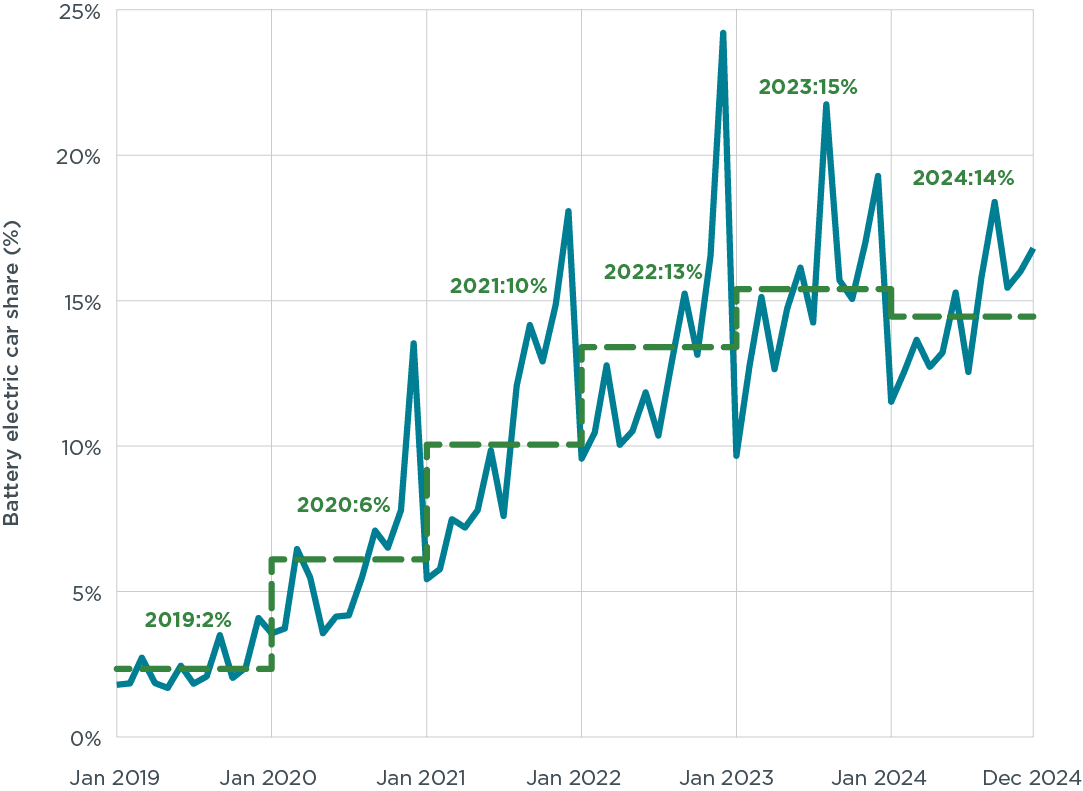
Figure 2. Average CO2 emissions of manufacturer pools and Tesla, a large manufacturer not part of a pool, in 2024, including compliance credits, compared with their estimated 2024 targets.
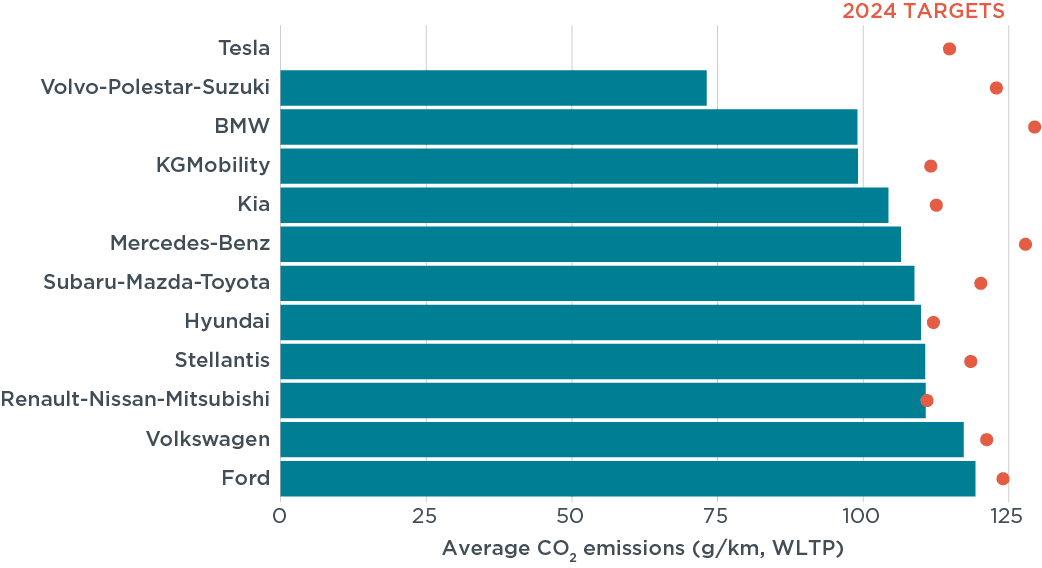
Note: All CO2 values are estimates according to the Worldwide harmonized Light vehicles Test Procedure (WLTP). See the section on definitions, data sources, methodology, and assumptions for details.
Average CO2 emissions among manufacturer pools and Tesla, a large manufacturer not part of an official pool, fell to 108 g CO2/km in 2024, with an average of 103 g CO2/km in December. All manufacturer pools reached their 2024 targets; on average, over-compliance was 12 g CO2/km, based on an average target of 119 g CO2/km. Volvo-Polestar-Suzuki showed the greatest over-compliance (50 g CO2/km below) while Renault-Nissan-Mitsubishi just met its target. Looking at individual car brands, apart from Tesla, Volvo had the greatest over-compliance at 67 g CO2/km below its pool target for 2024, followed by BMW (30 g CO2/km below). Meanwhile, Nissan, Dacia, SEAT, and Citroën exceeded their 2024 pool targets by 10, 6, 4, and 1 g CO2/ km, respectively.
Table 1. Share of battery electric, plug-in hybrid, full hybrid, and mild hybrid passenger cars by manufacturer pool and Tesla, a large manufacturer not part of a pool
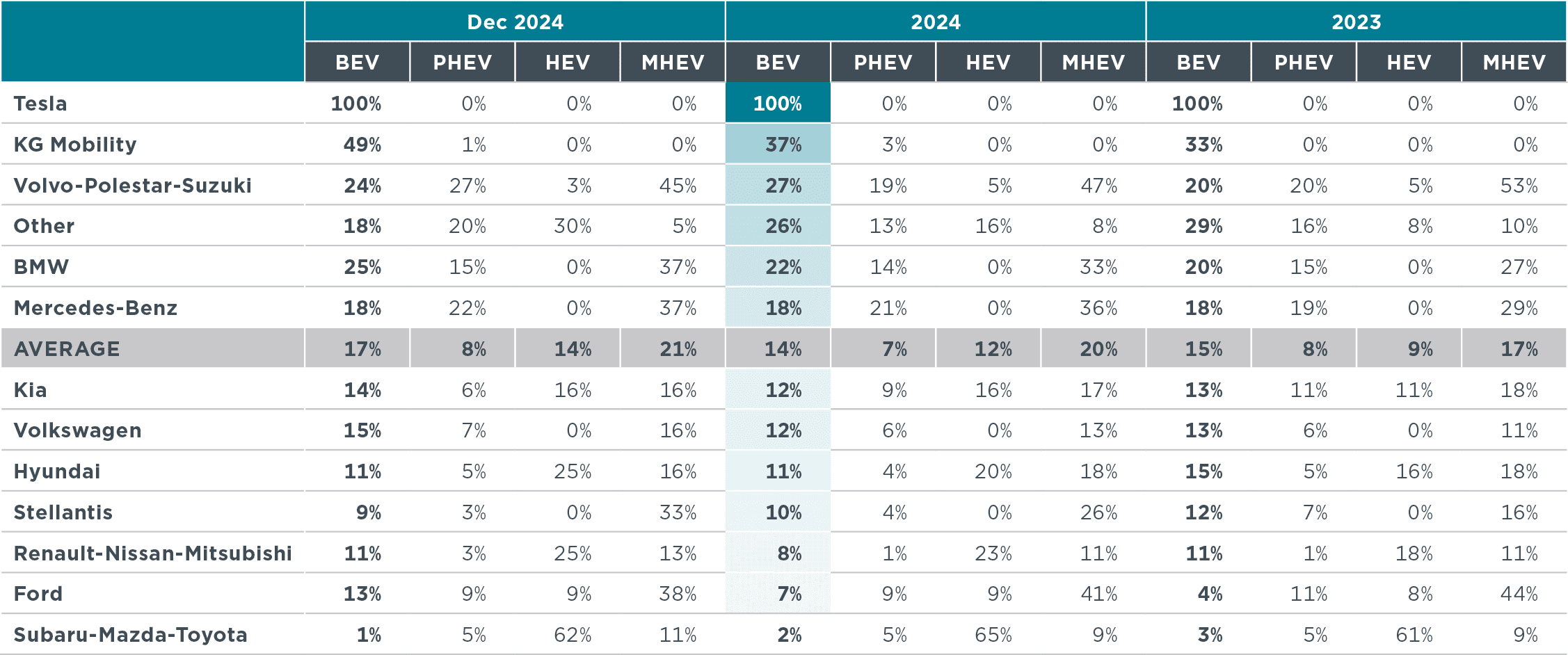
Table 2. Fleet-average CO2 emissions of new passenger cars and market share by manufacturer pool and Tesla, a large manufacturer not part of a pool
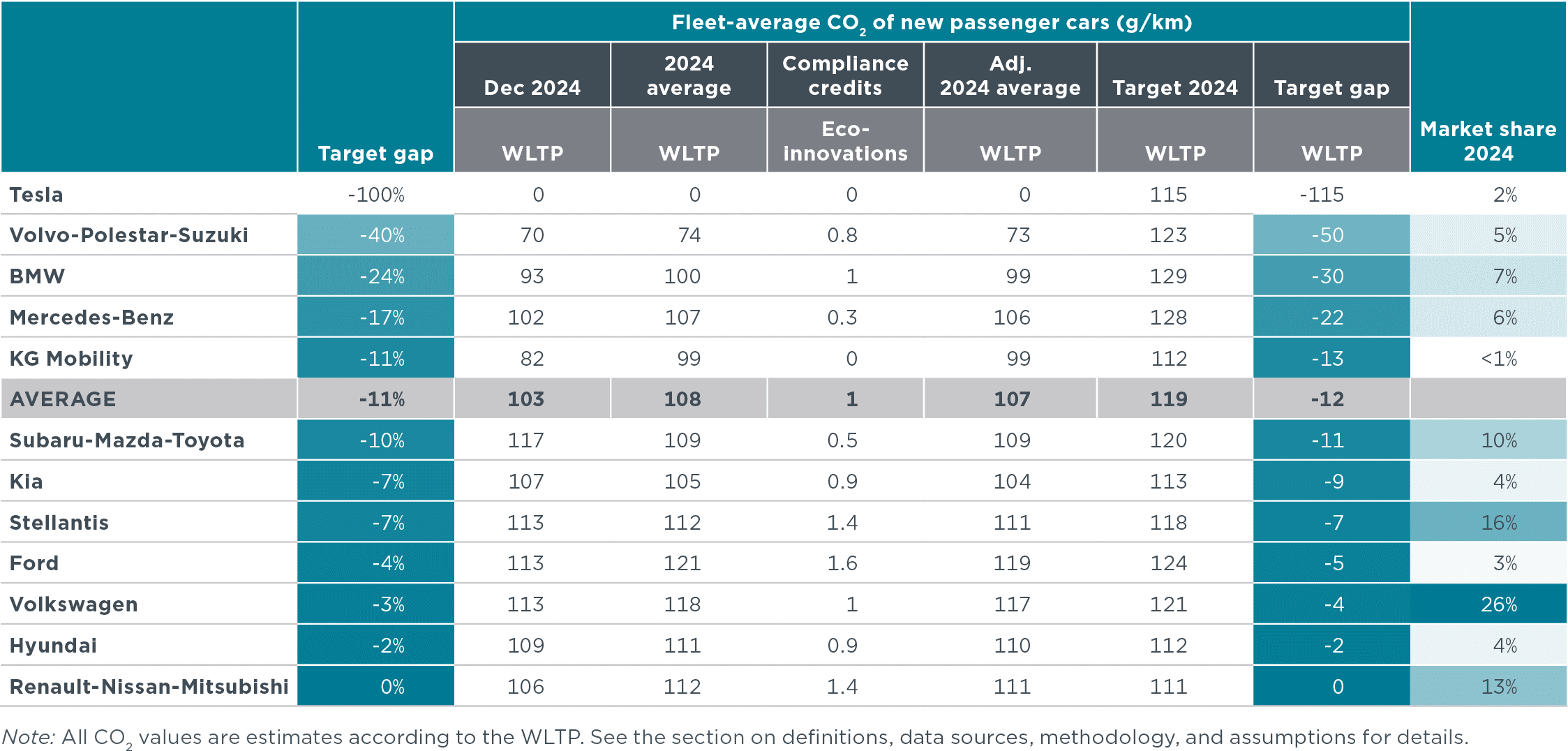
Table 3. New passenger car fleet-average CO2 emissions level and market share of the 20 largest brands in terms of 2024 new registration numbers
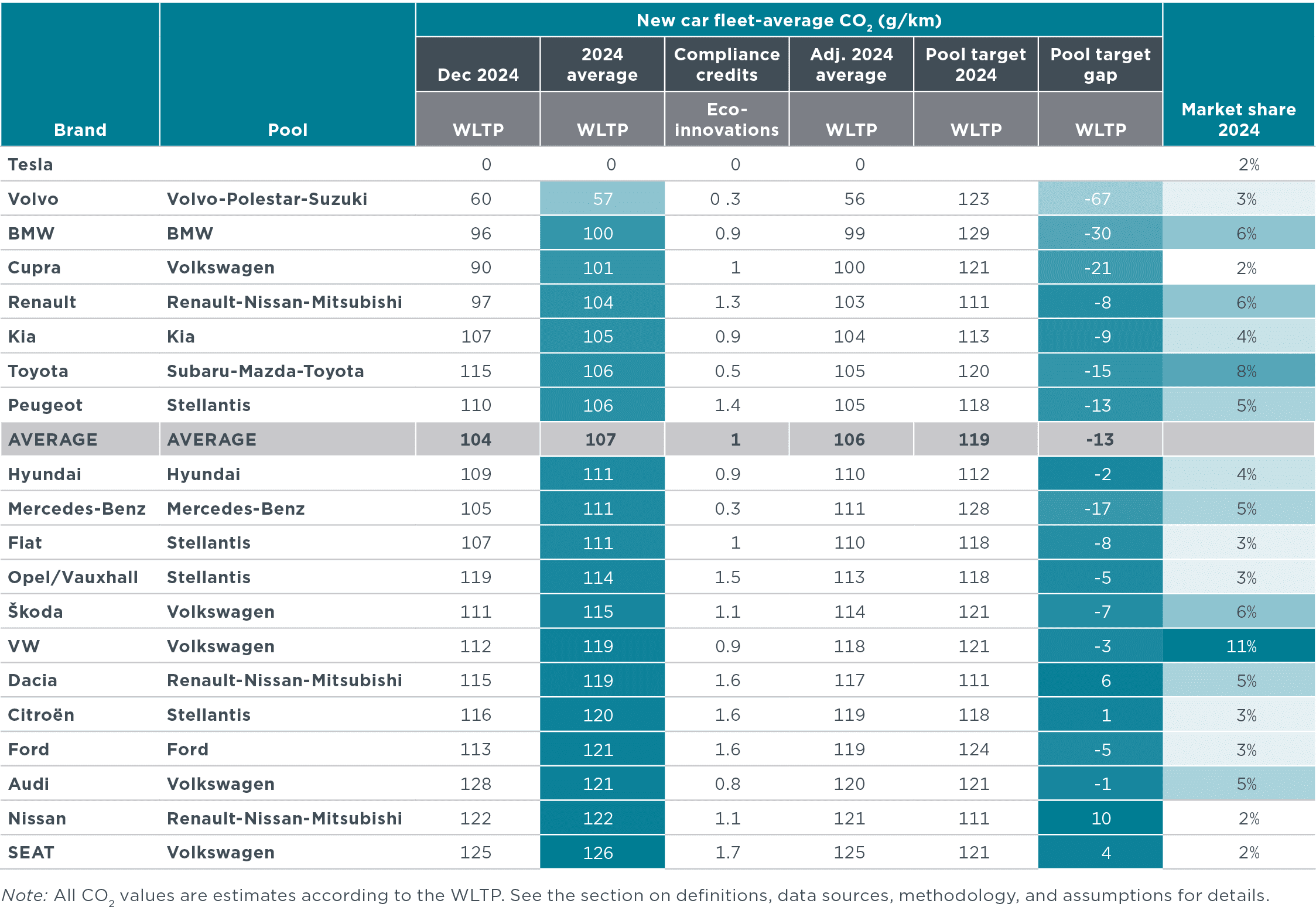
Passenger car registrations by country
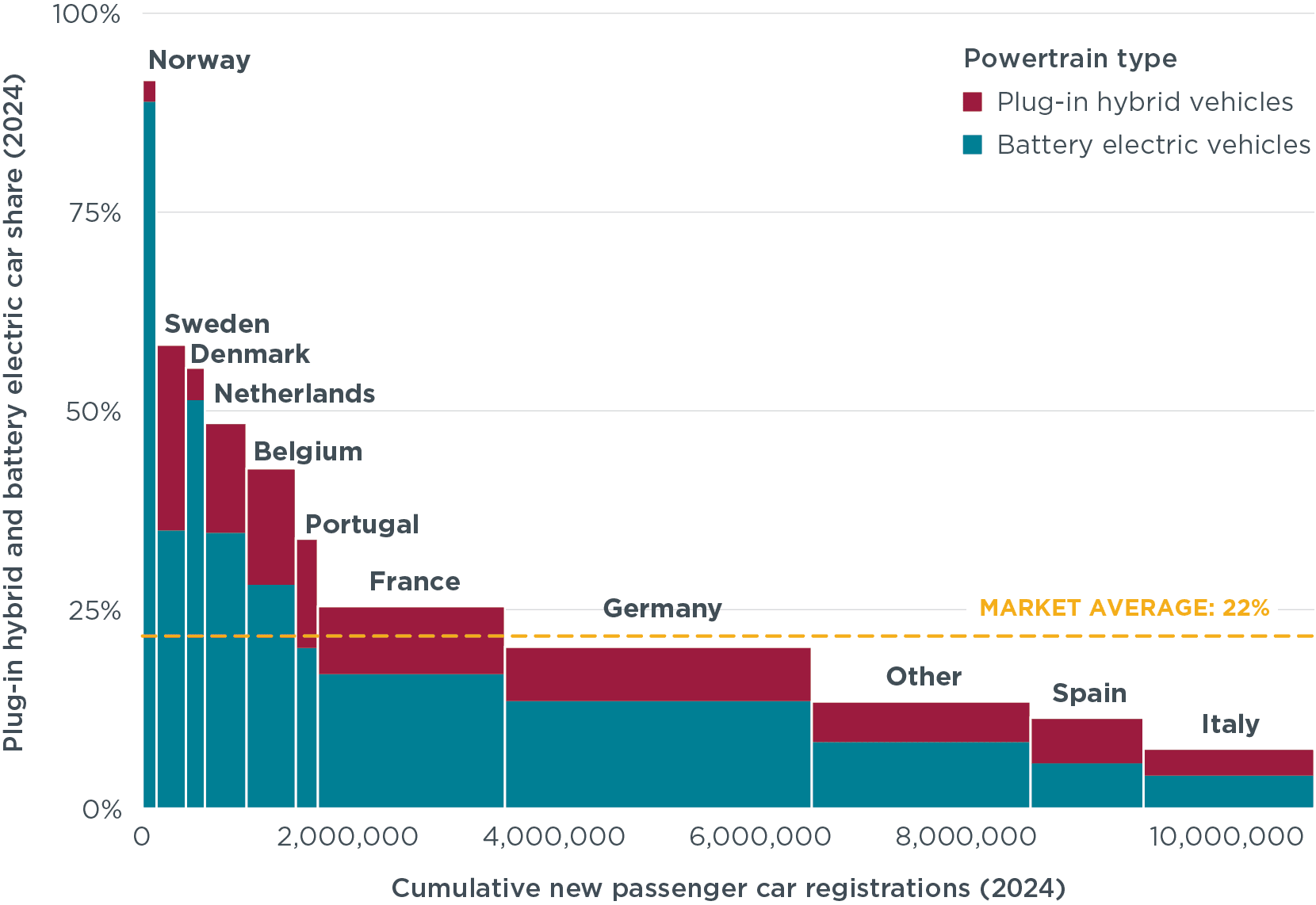
Table 4. New passenger car registrations by country
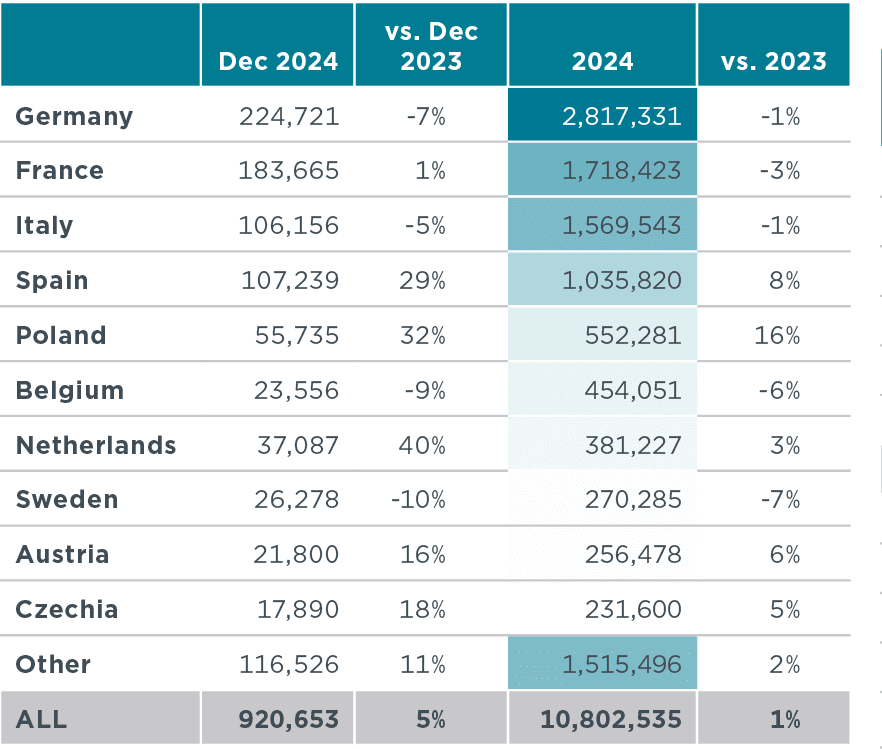
Table 5. Share of battery electric, plug-in hybrid, full hybrid, and mild hybrid passenger cars by country
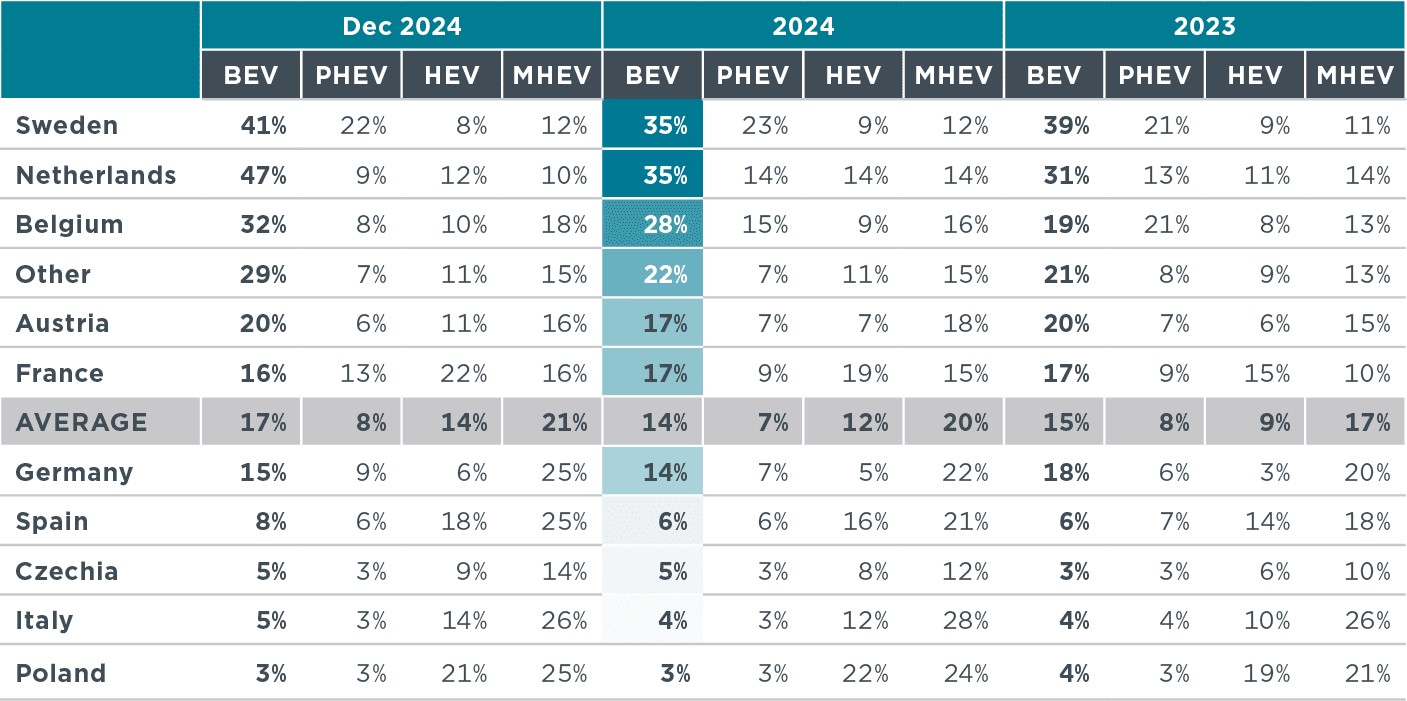
Passenger car registrations by owner
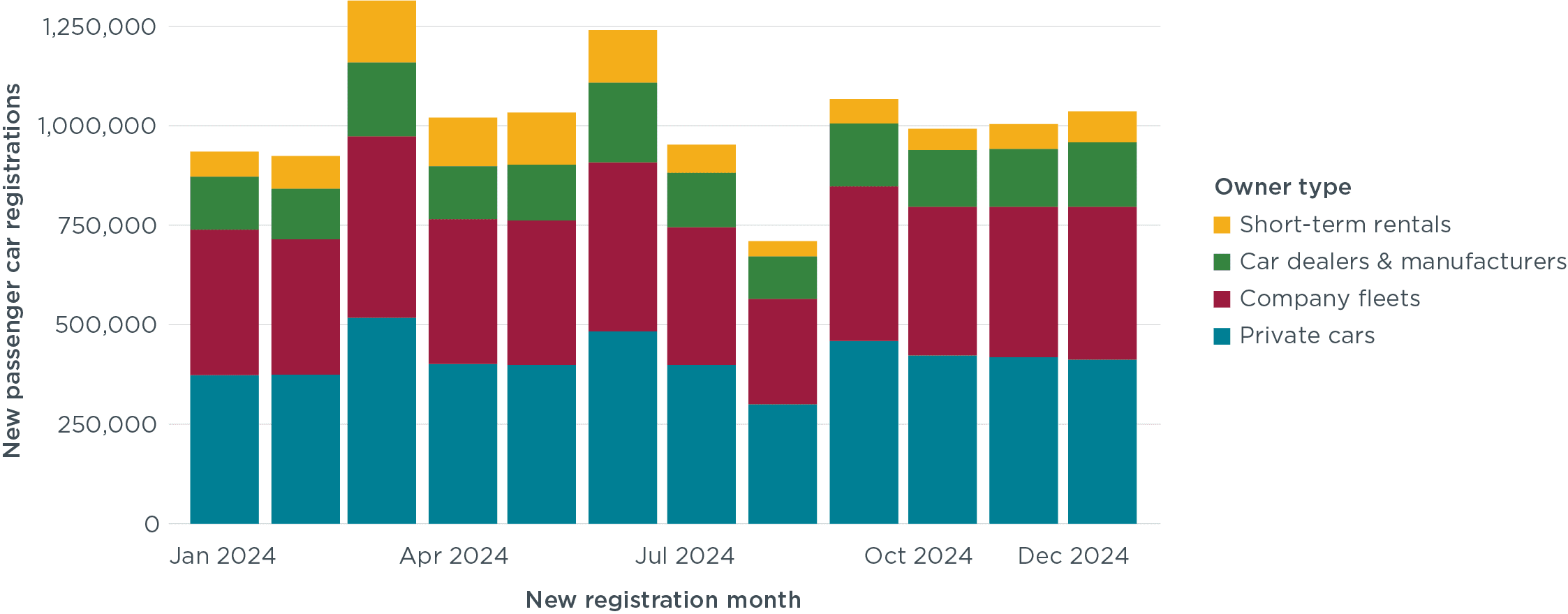
Van registrations
Over 1.5 million new vans were registered in Europe in 2024, a 7% increase over 2023. Of newly registered vans, 7% were battery electric in the fourth quarter of 2024, and the share for full-year 2024 was 6%, a slight decrease from the 7% average in 2023. While Volkswagen and other smaller manufacturing pools had BEV van shares of 8% in 2024, the Renault-Nissan (5%) and Ford (3%) pools remained below the European average. Looking at countries, the market share of battery electric vans dropped three percentage points to 5% in Germany in 2024, while the share other major countries either remained the same or dropped by one percentage point compared with the previous year. All manufacturers met their CO2 targets for 2024, with average overcompliance of 8 g CO2/km. Among manufacturer pools, Stellantis, with a market share of 30%, stood out with over-compliance of 15 g CO2/km, and Renault-Nissan over-complied by 1%.
Table 6. Share of battery electric, plug-in hybrid, hybrid, and mild hybrid vans by manufacturer pool

Table 7. New van fleet-average CO2 emissions and market share by manufacturer pool
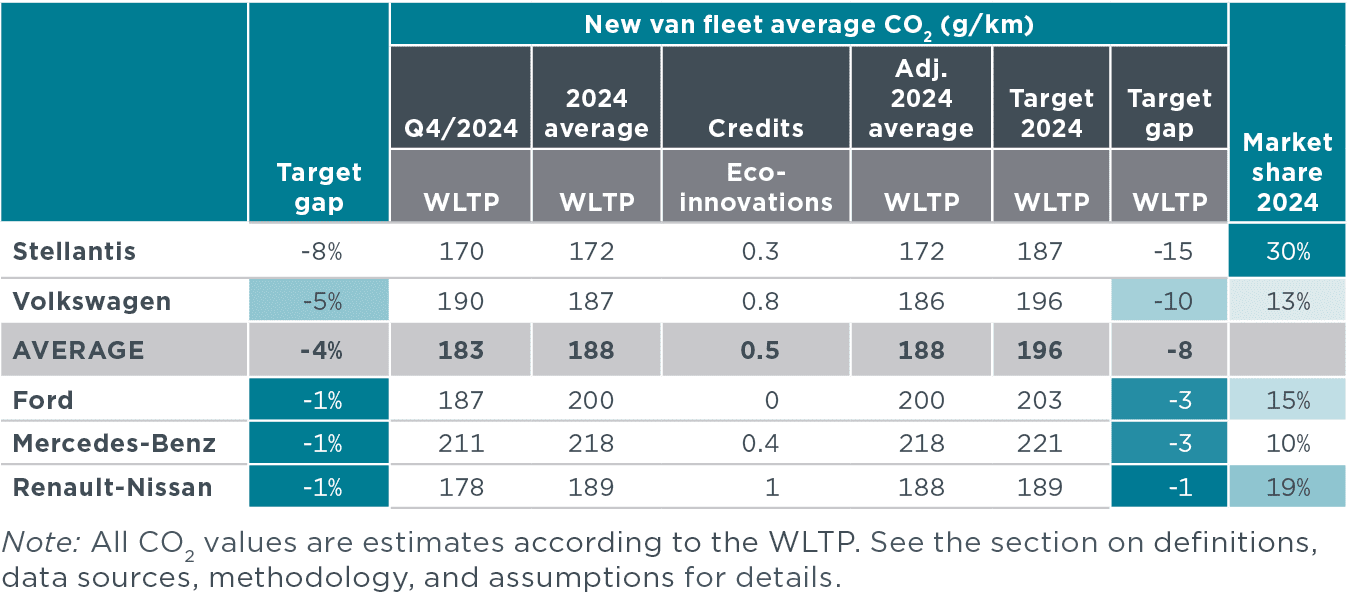
Table 8. New van registrations by country
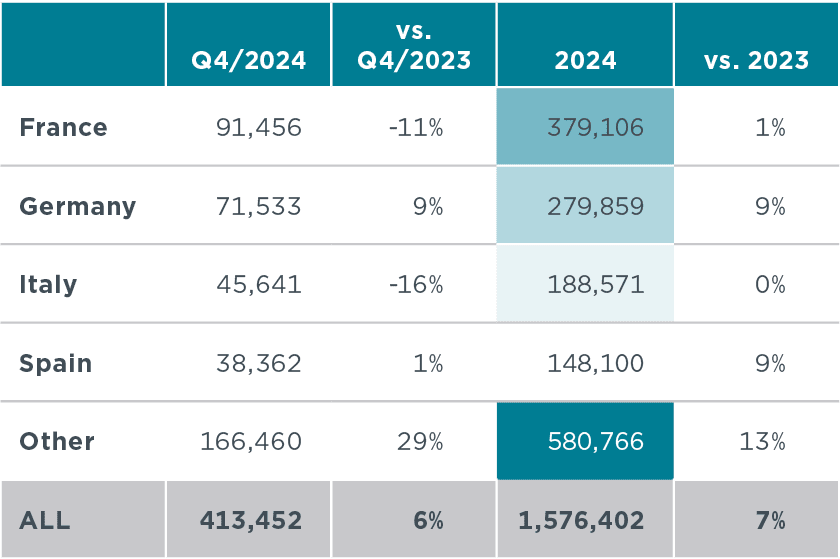
Table 9. Share of battery electric, plug-in hybrid, full hybrid, and mild hybrid vans by country

Charging infrastructure development
4.2 at the end of 2023. With 43 22 kW-equivalent publicly accessible charging points per thousand passenger cars and vans, Norway continues to lead Europe in charging infrastructure, followed by Iceland (32), Denmark (26), and Sweden (21). Italy and Spain (both 2.7) remain well below the European average.
Figure 5. 22 kW-equivalent publicly accessible charging points installed per thousand passenger cars and vans in Europe by the end of December 2024
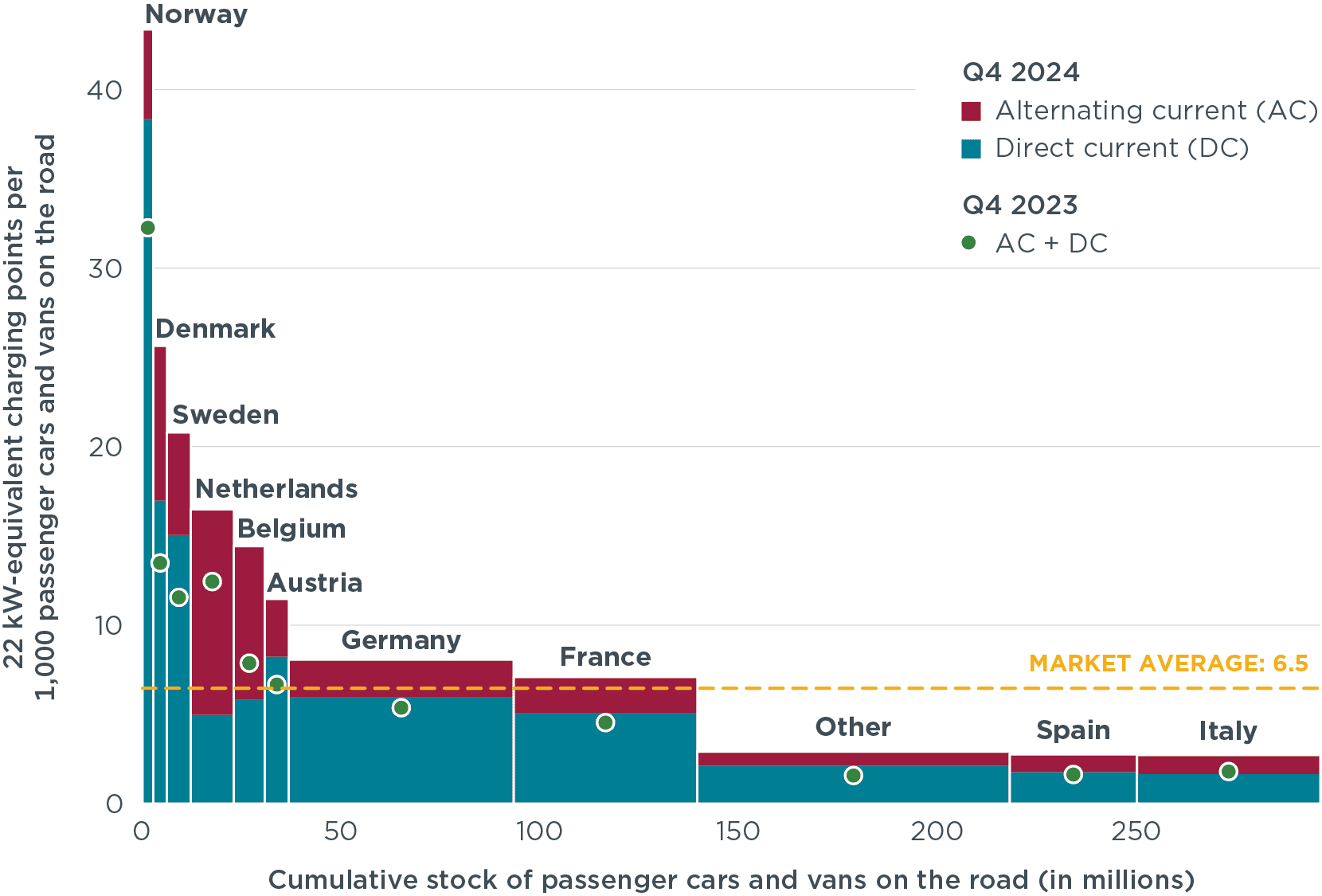
Note: The width of the bars represents stock size estimates as of the end of 2024. The unit 22 kW-equivalent is used to account for different power outputs while allowing for comparison among countries.
Table 10. Number of publicly accessible charging points installed by country and type of power output
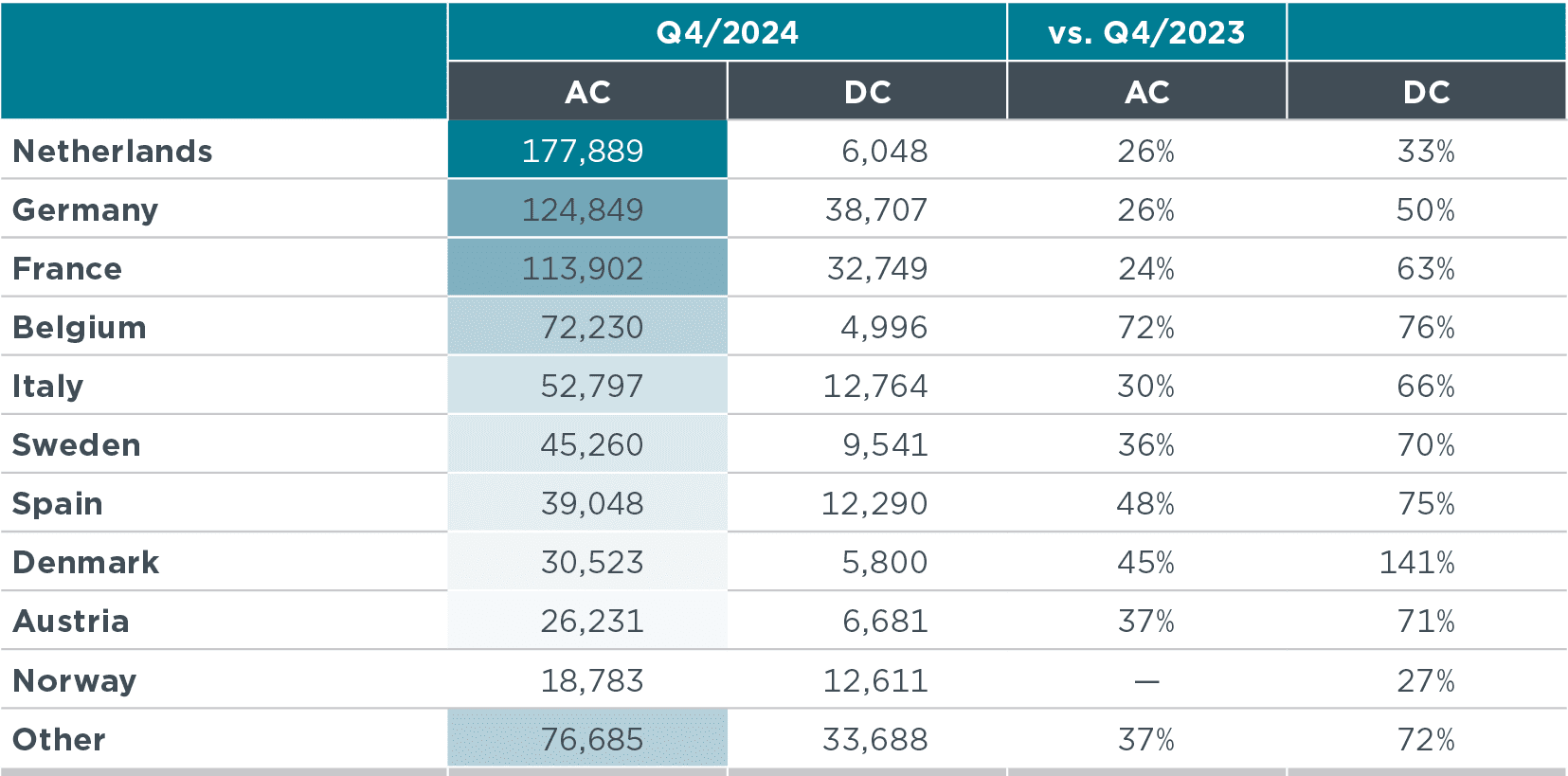
Definitions, data sources, methodology, and assumptions
Manufacturer pools: Automakers are allowed to form pools to jointly comply with CO2 targets. For this publication, the 2024 pools are defined according to the European Commission’s “M1 pooling list,” version of 15 January 2025, and the main brands are: BMW Group (BMW, Mini), Ford (Ford), Hyundai (Hyundai), KG Mobility (Great Wall Motor, Xpeng), Kia (Kia), Mercedes-Benz (Mercedes-Benz, Smart), Renault-Nissan-Mitsubishi (Dacia, Mitsubishi, Nissan, Renault), Stellantis (Alfa Romeo, Citroën, Fiat, Jeep, Lancia, Opel, Peugeot), Subaru-Mazda-Toyota (Lexus, Mazda, Subaru, Toyota), Volkswagen (Audi, Cupra, Porsche, SEAT, Škoda, VW), and Volvo-Polestar-Suzuki (Polestar, Suzuki, Volvo). For vans, the 2024 pools listed in “N1 pooling list,” version of 15 January 2025, applies: Ford (Ford), Mercedes-Benz (Mercedes-Benz, Mitsubishi Fuso), Renault-Nissan (Nissan, Renault), Stellantis (Citroën, Fiat, Opel, Peugeot), Volkswagen (MAN, Volkswagen). Tesla is a large M1 manufacturer that is not part of a pool.
Abbreviations: AC = alternating current; CO2 = carbon dioxide emissions; DC = direct current; g/km = grams per kilometer.
Technical scope: This publication focuses on new passenger car and van registrations. Battery electric vehicles (BEVs) are powered exclusively by an electric motor, with no additional source of propulsion. Plug-in hybrid electric vehicles (PHEVs) combine a conventional combustion engine with an electric propulsion system that can be recharged via an external power source. Hybrid electric vehicles here include full hybrid electric vehicles (HEVs) and mild hybrid electric vehicles (MHEVs). HEVs and MHEVs integrate two propulsion systems, usually a combustion engine and an electric propulsion system, which cannot be recharged via an external power source. Key differences between HEVs and MHEVs are the system voltage and system power. This enables HEVs to drive partially pure electric, while the electric propulsion system of MHEVs is typically only capable of assisting the combustion engine. For more on HEVs and MHEVs see: Jan Dornoff, John German, Ashok Deo, and Athanasios Dimaratos, Mild-Hybrid Vehicles: A Near Term Technology Trend for CO2 Emissions Reduction (International Council on Clean Transportation, 2022), https://theicct.org/publication/ mild-hybrid-emissions-jul22/.
Geographic scope: The European CO2 regulation for vehicle manufacturers applies to all countries of the European Economic Area (EEA). This includes the 27 Member States of the European Union plus Iceland, Liechtenstein, and Norway. Data for new car and van registrations and shares of electric vehicles in this publication cover all of these countries, with the exception of Bulgaria, Liechtenstein, and Malta. Data for CO2 emission levels additionally omits Romania. Charging infrastructure data are presented for the 27 EU members plus the four European Free Trade Association countries (Iceland, Liechtenstein, Norway, and Switzerland).
Data sources: Dataforce (new vehicle registrations), Eco-Movement (charging points), European Environment Agency (EEA) (vehicle mass and eco-innovation credits).
Results may change over time: Registrations and/or CO2 data may be retrospectively updated by some of the national type-approval authorities. Similarly, charging infrastructure data may also be retrospectively updated by Eco-Movement. Historical values are regularly updated to reflect all latest data available.
Test procedures: CO2 values are provided according to the Worldwide harmonized Light vehicles Test Procedure (WLTP).
Flexible compliance mechanisms: To facilitate meeting their CO2 targets, manufacturers can make use of a number of compliance mechanisms. Manufacturers can reduce their CO2 level by up to 7 g/km by deploying eco-innovation technologies. As a conservative estimate, we apply the 2023 level of eco-innovation CO2 emission reductions per brand. For more on the methodology used, see: Uwe Tietge, Peter Mock, and Jan Dornoff, Overview and Evaluation of Eco-Innovations in European Passenger Car CO2 Standards (International Council on Clean Transportation, 2018), https:// theicct.org/publications/eco-innovations-european-passenger-car-co2-standards.
Mass-based targets: For each manufacturer pool, a specific 2024 CO2 target value applies, depending on the average mass of the new vehicles registered. For this publication, we assume the average mass per manufacturer pool remains the same as in 2023; the average 2023 BEV and non-BEV mass for each manufacturer was calculated based on EEA data and then weighted according to their 2024 BEV market shares. For more on the methodology used see: Uwe Tietge, Jan Dornoff, and Peter Mock, CO2 Emissions From New Passenger Cars in Europe: Car Manufacturers’ Performance in 2023 (International Council Clean Transportation, 2024), https:// theicct.org/publication/co2-emissions-new-pv-europe-car-manufacturersperformance-2023-sept24/.
Charging point: As defined in the Alternative Fuels Infrastructure Regulation, a charging point “means a fixed or mobile interface that allows for the transfer of electricity to an electric vehicle, which, whilst it may have one or several connectors to accommodate different connector types, is capable of recharging only one electric vehicle at a time, and excludes devices with a power output less than or equal to 3.7 kW the primary purpose of which is not recharging electric vehicles.”
Owner types: This publication considers four types of owners: private cars, company fleets, short-term rentals, and car dealers and manufacturers. The private car category includes all registrations under private individuals, including those of self employed persons, provided the vehicles are not registered under a company name. Private leasing is also included. Company fleets encompass all vehicles registered to companies, excluding those intended for resale or rental. This category includes company and public administration fleets, commercial long-term rentals, commercial leases, taxis, driving schools, diplomats, etc. The size of the fleet and the extent to which the vehicles are used privately are not considered relevant. The short-term rentals type covers all registrations under large or small national and local rental companies. It also covers all vehicles flagged by authorities as being used for self drive rental purposes. The car dealers and manufacturers type includes all vehicles registered by car dealers and manufacturers. For automakers, this includes vehicles used for press purposes as well as those for their own employees. New registrations data by registration type is aggregated for the following 20 European countries: Austria, Belgium, Czechia, Denmark, Finland, France, Germany, Iceland, Italy, Latvia, Lithuania, the Netherlands, Norway, Poland, Portugal, Slovakia, Spain, Sweden, Switzerland, and United Kingdom.
From the authors: With the next stage of the European Union’s new vehicle carbon dioxide (CO2 ) emissions targets taking effect in 2025, lots of eyes are on automaker performance. To provide up-to-date data for discussion, we plan to release monthly updates on European passenger car registrations throughout 2025, and quarterly updates on van registrations and charging infrastructure developments.

This publication is a collaboration between the ICCT, IMT-IDDRI, and ECCO think tank.
